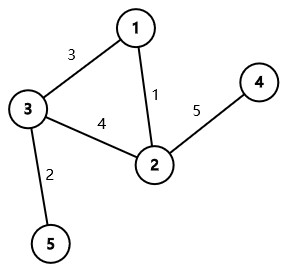You are given a connected undirected graph consisting of
vertices and edges. The weight of the -th edge is .
Here is a wrong algorithm of finding a minimum spanning tree (MST) of a graph:
vis := an array of length n
s := a set of edges
function dfs(u):
vis[u] := true
iterate through each edge (u, v) in the order from smallest to largest edge weight
if vis[v] = false
add edge (u, v) into the set (s)
dfs(v)
function findMST(u):
reset all elements of (vis) to false
reset the edge set (s) to empty
dfs(u)
return the edge set (s)
Each of the calls findMST(1), findMST(2), ..., findMST(n) gives you a spanning tree of the graph. Determine which of these trees are minimum spanning trees.
The first line of the input contains two integers , (, ) — the number of vertices and the number of edges in the graph.
Each of the following lines contains two integers and (, ), describing an undirected edge in the graph. The -th edge in the input has weight .
It is guaranteed that the graph is connected and there is at most one edge between any pair of vertices.
You need to output a binary string , where if findMST(i) creates an MST, and otherwise.
5 5 1 2 3 5 1 3 3 2 4 2
01111
10 11 1 2 2 5 3 4 4 2 8 1 4 5 10 5 9 5 8 2 5 7 4 6
0011111011
Here is the graph given in the first example.

There is only one minimum spanning tree in this graph. A minimum spanning tree is which has weight .
Here is a part of the process of calling findMST(1):
- reset the array vis and the edge set s;
- calling dfs(1);
- vis[1] := true;
- iterate through each edge ;
- add edge into the edge set s, calling dfs(2):
- vis[2] := true
- iterate through each edge ;
- because vis[1] = true, ignore the edge ;
- add edge into the edge set s, calling dfs(3):
- ...
In the end, it will select edges with total weight , so findMST(1) does not find a minimum spanning tree.
It can be shown that the other trees are all MSTs, so the answer is 01111.

No comments:
Post a Comment